Climate Change and Habitat Fragmentation: Implications for the Future Distribution and Assisted Migration of Kobresia pygmaea
Abstract
1. Introduction
2. Materials and Methods
2.1. Sources of Species Distribution Data
2.2. Environment Variable Data and Screening
2.3. MaxEnt Model Optimization and Parameter Setting
2.4. Suitable Area Division and Area Calculation
2.5. Temporal and Spatial Evolution of Suitable Areas
3. Results and Analysis
3.1. Species Distribution Sites and Filtering Results of Environmental Variables
3.2. MaxEnt Accuracy Evaluation
3.3. Key Environmental Variables Affecting the Distribution of K. pygmaea
3.4. Suitable Areas for K. pygmaea Under Current Climate Conditions
3.5. Suitable Area of K. pygmaea in Different Climate Scenarios in the Future
3.6. Trends in the Gain and Loss of Suitable Habitat Area for K. pygmaea Under Future Climate Change Scenarios
3.7. Centroid Shift Trends of K. pygmaea Under Future Climate Scenarios
4. Discussion
4.1. Evaluation of the MaxEnt Model
4.2. Key Environmental Variables Influencing the Distribution of K. pygmaea
4.3. Response of the Geographical Distribution of K. pygmaea to Future Climate Change
4.4. Limitations and Innovations of the Study
5. Conclusions
Author Contributions
Funding
Data Availability Statement
Acknowledgments
Conflicts of Interest
References
- Kantamaneni, K.; Rice, L.; Yenneti, K.; Campos, L.C. Assessing the Vulnerability of Agriculture Systems to Climate Change in Coastal Areas: A Novel Index. Sustainability 2020, 12, 4771. [Google Scholar] [CrossRef]
- Pauls, S.U.; Nowak, C.; Bálint, M.; Pfenninger, M. The impact of global climate change on genetic diversity within populations and species. Mol. Ecol. 2013, 22, 925–946. [Google Scholar] [CrossRef] [PubMed]
- Li, F.; Lv, L.; Bao, S.; Cai, Z.; Fu, S.; Shi, J. Evaluation and Application of the MaxEnt Model to Quantify L. nanum Habitat Distribution Under Current and Future Climate Conditions. Agronomy 2025, 15, 1869. [Google Scholar] [CrossRef]
- Barrett, M.A.; Brown, J.L.; Junge, R.E.; Yoder, A.D. Climate change, predictive modeling and lemur health: Assessing impacts of changing climate on health and conservation in Madagascar. Biol. Conserv. 2013, 157, 409–422. [Google Scholar] [CrossRef]
- Vaissi, S. Response of Iranian lizards to future climate change by poleward expansion, southern contraction, and elevation shifts. Sci. Rep. 2022, 12, 2348. [Google Scholar] [CrossRef] [PubMed]
- Pauchard, A.; Milbau, A.; Albihn, A.; Alexander, J.; Burgess, T.; Daehler, C.; Englund, G.; Essl, F.; Evengård, B.; Greenwood, G.B.; et al. Non-native and native organisms moving into high elevation and high latitude ecosystems in an era of climate change: New challenges for ecology and conservation. Biol. Invasions 2016, 18, 345–353. [Google Scholar] [CrossRef]
- Surmal, O.; Singh, B.; Musarella, C.M. Understanding Species Diversity, Phenology and Environmental Implications of Different Life Forms in Coniferous Forests: A Case Study from Bhallesa Hills of Pir Panjal Mountain, Western Himalaya, India. Forests 2022, 13, 2050. [Google Scholar] [CrossRef]
- Engler, R.; Randin, C.F.; Thuiller, W.; Dullinger, S.; Zimmermann, N.E.; Araújo, M.B.; Pearman, P.B.; Le Lay, G.; Piedallu, C.; Albert, C.H.; et al. 21st century climate change threatens mountain flora unequally across Europe. Glob. Change Biol. 2011, 17, 2330–2341. [Google Scholar] [CrossRef]
- Gilg, O.; Kovacs, K.M.; Aars, J.; Fort, J.; Gauthier, G.; Grémillet, D.; Ims, R.A.; Meltofte, H.; Moreau, J.; Post, E.; et al. Climate change and the ecology and evolution of Arctic vertebrates. Ann. N. Y. Acad. Sci. 2012, 1249, 166–190. [Google Scholar] [CrossRef]
- Schippers, P.; Abarca, E.L.; Verboom, J.; Wamelink, G.W.W.; Vos, C.C.; de Boer, W.F.; Harvey, J.A.; Essens, T.; Grashof-Bokdam, C.J.; WallisDeVries, M.F.; et al. Biodiversity conservation in climate change driven transient communities. Biodivers. Conserv. 2021, 30, 2885–2906. [Google Scholar] [CrossRef]
- Elith, J.; Phillips, S.J.; Hastie, T.; Dudík, M.; Chee, Y.E.; Yates, C.J. A statistical explanation of MaxEnt for ecologists. Divers. Distrib. 2011, 17, 43–57. [Google Scholar] [CrossRef]
- Melo-Merino, S.M.; Reyes-Bonilla, H.; Lira-Noriega, A. Ecological niche models and species distribution models in marine environments: A literature review and spatial analysis of evidence. Ecol. Model. 2020, 415, 108837. [Google Scholar] [CrossRef]
- Tyack, N.; Dempewolf, H.; Khoury, C.K. The Potential of Payment for Ecosystem Services for Crop Wild Relative Conservation. Plants 2020, 9, 1305. [Google Scholar] [CrossRef]
- Xiao, Y.; Guo, Q.; Xie, N.; Yuan, G.; Liao, M.; Gui, Q.; Ding, G. Predicting the global potential distribution of Bursaphelenchus xylophilus using an ecological niche model: Expansion trend and the main driving factors. BMC Ecol. Evol. 2024, 24, 48. [Google Scholar] [CrossRef]
- Phillips, S.J.; Dudík, M. Modeling of Species Distributions with Maxent: New Extensions and a Comprehensive Evaluation. Ecography 2008, 31, 161–175. [Google Scholar] [CrossRef]
- Zhang, H.; Song, J.; Zhao, H.; Li, M.; Han, W. Predicting the Distribution of the Invasive Species Leptocybe invasa: Combining MaxEnt and Geodetector Models. Insects 2021, 12, 92. [Google Scholar] [CrossRef]
- Barve, N.; Barve, V.; Jiménez-Valverde, A.; Lira-Noriega, A.; Maher, S.P.; Townsend Peterson, A.; Soberon, J.; Villalobos, F. The crucial role of the accessible area in ecological niche modeling and species distribution modeling. Ecol. Model. 2011, 222, 1810–1819. [Google Scholar] [CrossRef]
- Rocchini, D.; Andreo, V.; Förster, M.; Garzon-Lopez, C.X.; Gutierrez, A.P.; Gillespie, T.W.; Hauffe, H.C.; He, K.S.; Kleinschmit, B.; Mairota, P.; et al. Potential of remote sensing to predict species invasions. Prog. Phys. Geogr. Earth Environ. 2015, 39, 283–309. [Google Scholar] [CrossRef]
- Lin, L.; Cao, G.; Xu, X.; Zhang, F.; Huang, J.; Fan, B.; Li, B.; Li, Y. Kobresia pygmaea meadows as disclimax communities in the same geographic and climatic environments in Qinghai–Tibet Plateau, China. J. Plant Ecol. 2023, 16, rtad010. [Google Scholar] [CrossRef]
- Yang, Y.; Wang, G.; Klanderud, K.; Yang, L. Responses in leaf functional traits and resource allocation of a dominant alpine sedge (Kobresia pygmaea) to climate warming in the Qinghai-Tibetan Plateau permafrost region. Plant Soil 2011, 349, 377–387. [Google Scholar] [CrossRef]
- Zhou, H.; Yang, X.; Zhou, C.; Shao, X.; Shi, Z.; Li, H.; Su, H.; Qin, R.; Chang, T.; Hu, X.; et al. Alpine Grassland Degradation and Its Restoration in the Qinghai–Tibet Plateau. Grasses 2023, 2, 31–46. [Google Scholar] [CrossRef]
- Knowles, N.L.B.; Scott, D.; Steiger, R. Climate Change and the Future of Ski Tourism in Canada’s Western Mountains. Tour. Hosp. 2024, 5, 187–202. [Google Scholar] [CrossRef]
- Reddy, N.M.; Saravanan, S. Extreme precipitation indices over India using CMIP6: A special emphasis on the SSP585 scenario. Environ. Sci. Pollut. Res. 2023, 30, 47119–47143. [Google Scholar] [CrossRef] [PubMed]
- Gütschow, J.; Jeffery, M.L.; Günther, A.; Meinshausen, M. Country-resolved combined emission and socio-economic pathways based on the Representative Concentration Pathway (RCP) and Shared Socio-Economic Pathway (SSP) scenarios. Earth Syst. Sci. Data 2021, 13, 1005–1040. [Google Scholar] [CrossRef]
- Zhang, K.; Yao, L.; Meng, J.; Tao, J. Maxent modeling for predicting the potential geographical distribution of two peony species under climate change. Sci. Total Environ. 2018, 634, 1326–1334. [Google Scholar] [CrossRef]
- Li, J.; Fan, G.; He, Y. Predicting the current and future distribution of three Coptis herbs in China under climate change conditions, using the MaxEnt model and chemical analysis. Sci. Total Environ. 2020, 698, 134141. [Google Scholar] [CrossRef]
- Valjarević, A.; Milanović, M.; Gultepe, I.; Filipović, D.; Lukić, T. Updated Trewartha climate classification with four climate change scenarios. Geogr. J. 2022, 188, 506–517. [Google Scholar] [CrossRef]
- Huang, R.; Du, H.; Wen, Y.; Zhang, C.; Zhang, M.; Lu, H.; Wu, C.; Zhao, B. Predicting the distribution of suitable habitat of the poisonous weed Astragalus variabilis in China under current and future climate conditions. Front. Plant Sci. 2022, 13, 921310. [Google Scholar] [CrossRef] [PubMed]
- Cheng, G.; Wu, T. Responses of permafrost to climate change and their environmental significance, Qinghai-Tibet Plateau. J. Geophys. Res. Earth Surf. 2007, 112, F02S03. [Google Scholar] [CrossRef]
- Li, M.; Wang, J.B.; Zhang, X.J.; Zhang, Y.; Wang, R.; Yang, Y.S. Distibution of potential suitable areas of dominant species in aipine graslands and alpine meadows in the TP under future climate seenarios. Aeta Eeologica Sin. 2024, 44, 10162–10177. [Google Scholar] [CrossRef]
- Munzbergova, Z. Effect of spatial scale on factors limiting species distributions in dry grassland fragments. J. Ecol. 2004, 92, 854–867. [Google Scholar] [CrossRef]
- Randin, C.F.; Engler, R.; Normand, S.; Zappa, M.; Zimmermann, N.E.; Pearman, P.B.; Vittoz, P.; Thuiller, W.; Guisan, A. Climate change and plant distribution: Local models predict high-elevation persistence. Glob. Change Biol. 2009, 15, 1557–1569. [Google Scholar] [CrossRef]
- Ferguglia, O.; Palazzi, E.; Arnone, E. Elevation dependent change in ERA5 precipitation and its extremes. Clim. Dynam 2024, 62, 8137–8153. [Google Scholar] [CrossRef]
- Liu, M.; Zhang, G.; Yin, F.; Wang, S.; Li, L. Relationship between biodiversity and ecosystem multifunctionality along the elevation gradient in alpine meadows on the eastern Qinghai-Tibetan plateau. Ecol. Indic. 2022, 141, 109097. [Google Scholar] [CrossRef]
- Telwala, Y.; Brook, B.W.; Manish, K.; Pandit, M.K. Climate-induced elevational range shifts and increase in plant species richness in a Himalayan biodiversity epicentre. PLoS ONE 2013, 8, e57103. [Google Scholar] [CrossRef]
- Haddad, N.M.; Brudvig, L.A.; Clobert, J.; Davies, K.F.; Gonzalez, A.; Holt, R.D.; Lovejoy, T.E.; Sexton, J.O.; Austin, M.P.; Collins, C.D.; et al. Habitat fragmentation and its lasting impact on Earth’s ecosystems. Sci. Adv. 2015, 1, e1500052. [Google Scholar] [CrossRef]
- Hoegh-Guldberg, O.; Jacob, D.; Taylor, M.; Bolaños, T.G.; Bindi, M.; Brown, S.; Camilloni, I.A.; Diedhiou, A.; Djalante, R.; Ebi, K.; et al. The human imperative of stabilizing global climate change at 1.5 °C. Science 2019, 365, eaaw6974. [Google Scholar] [CrossRef]
- Ricciardi, A.; Simberloff, D. Assisted colonization is not a viable conservation strategy. Trends Ecol. Evol. 2009, 24, 248–253. [Google Scholar] [CrossRef]
- Hewitt, N.; Klenk, N.; Smith, A.L.; Bazely, D.; Yan, N.; Wood, S.; MacLellan, J.; Lipsig-Mumme, C.; Henriques, I. Taking stock of the assisted migration debate. Biol. Conserv. 2011, 144, 2560–2572. [Google Scholar] [CrossRef]
- Mueller, J.M.; Hellmann, J.J. An Assessment of Invasion Risk from Assisted Migration. Conserv. Biol. 2008, 22, 562–567. [Google Scholar] [CrossRef] [PubMed]

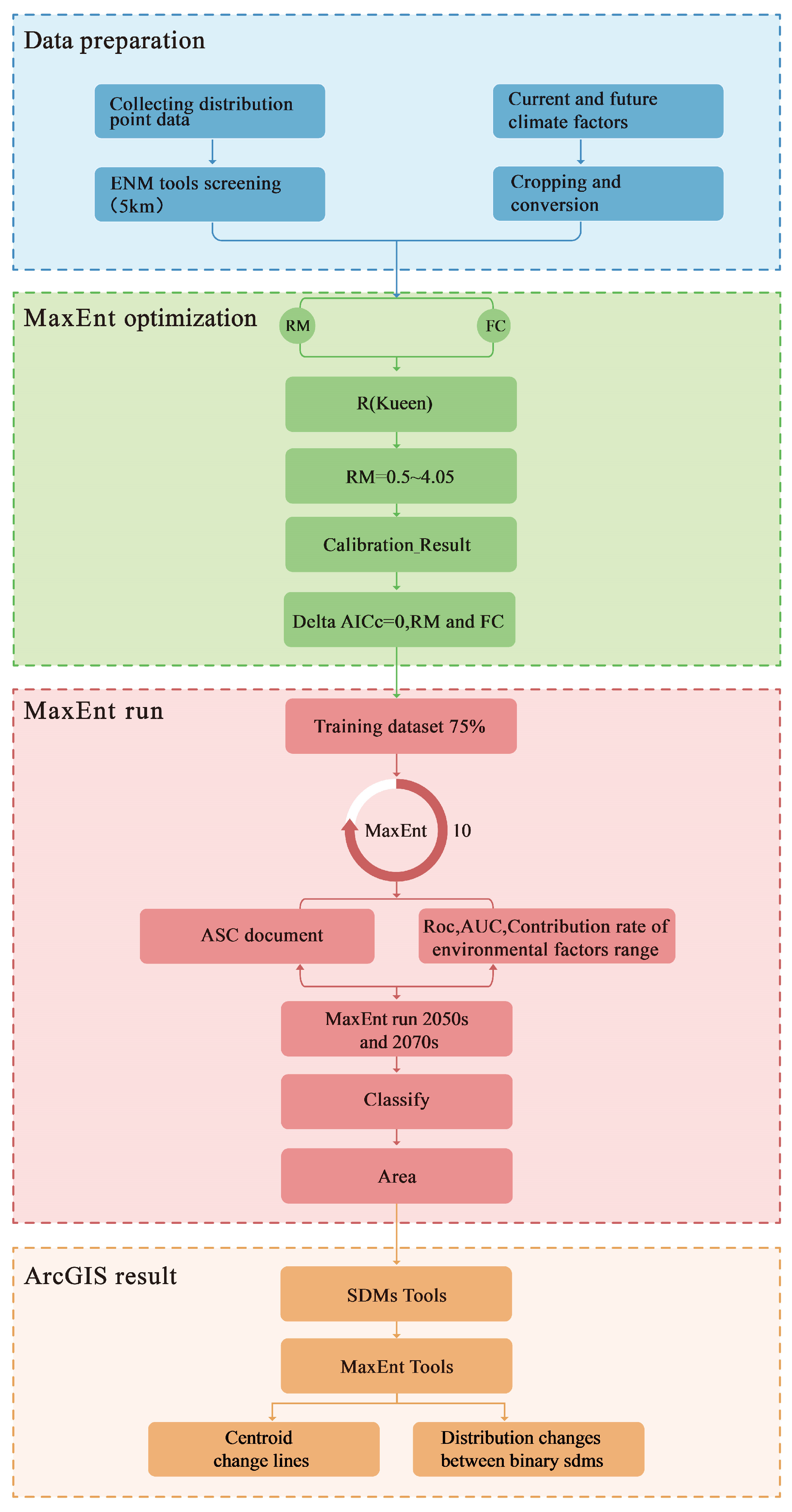
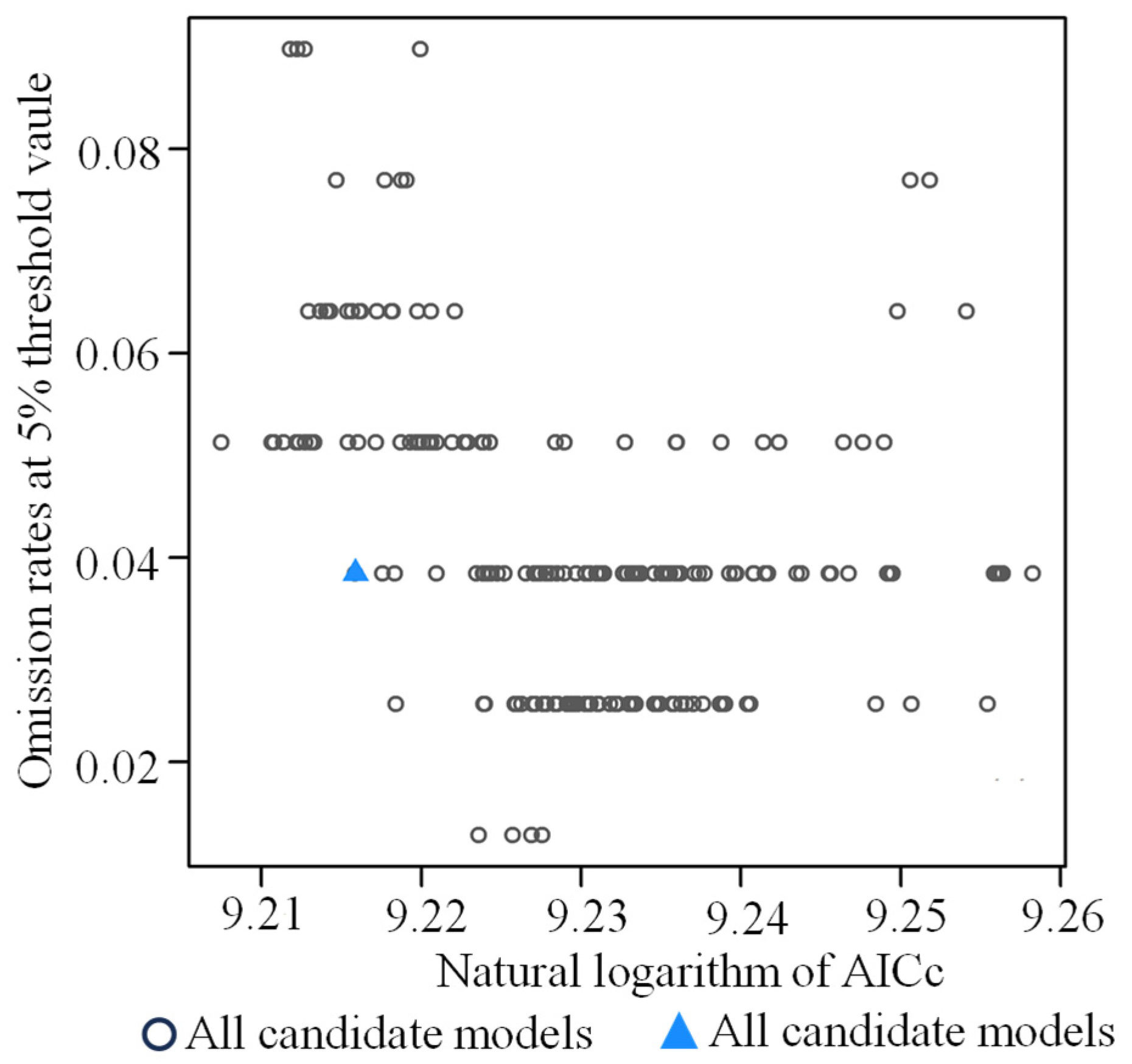

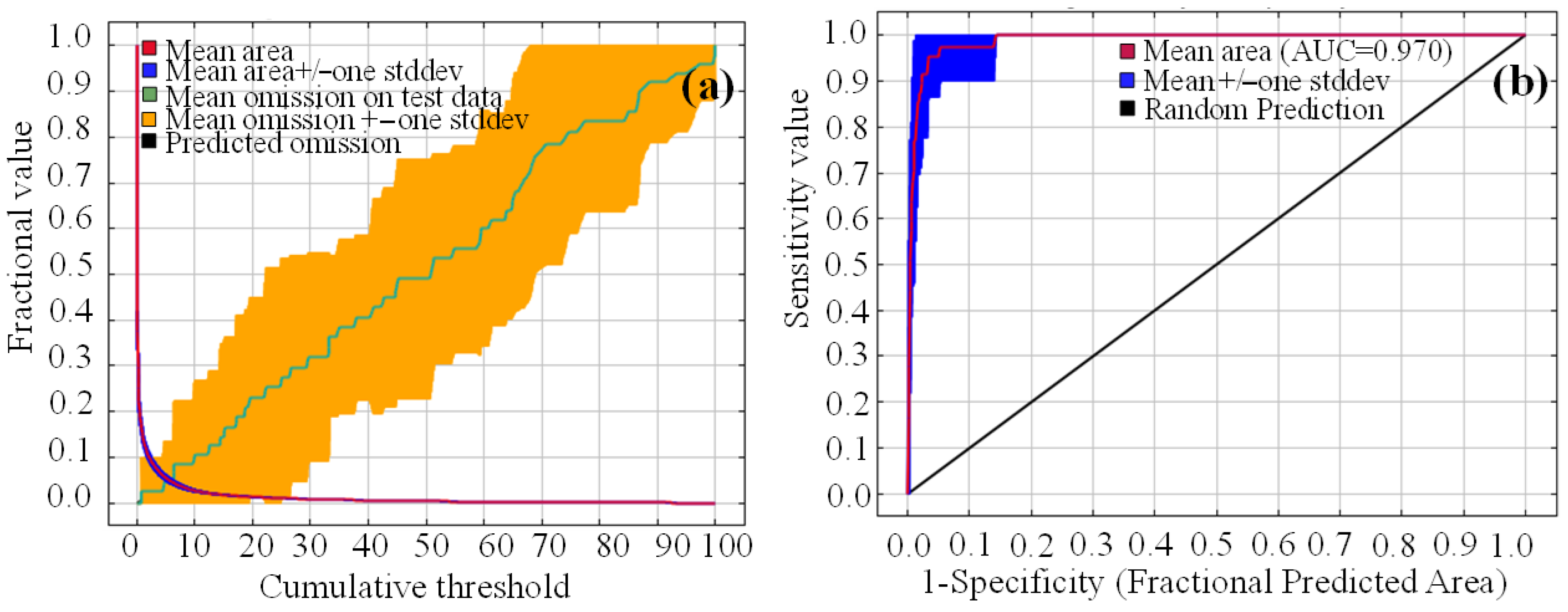
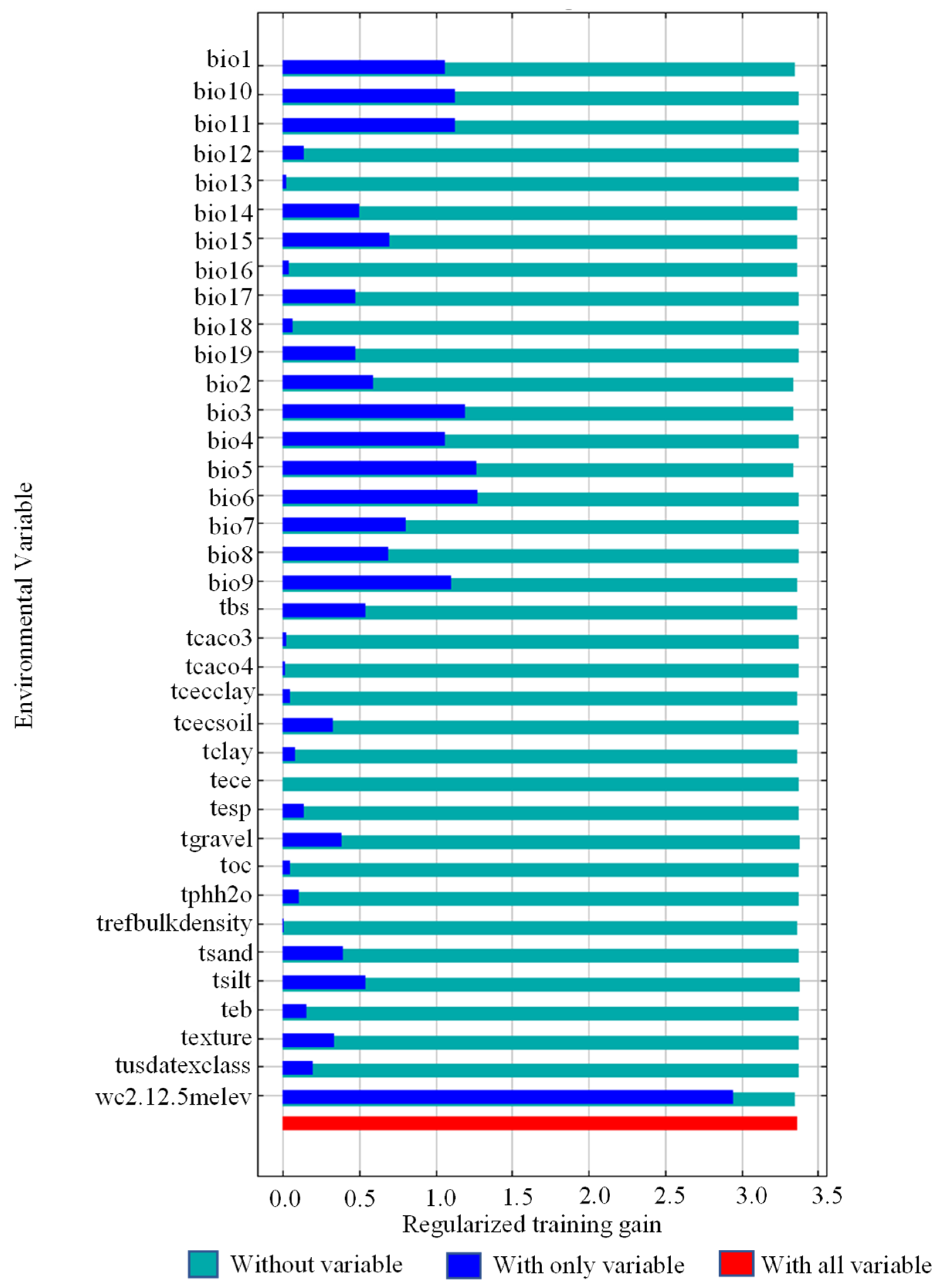
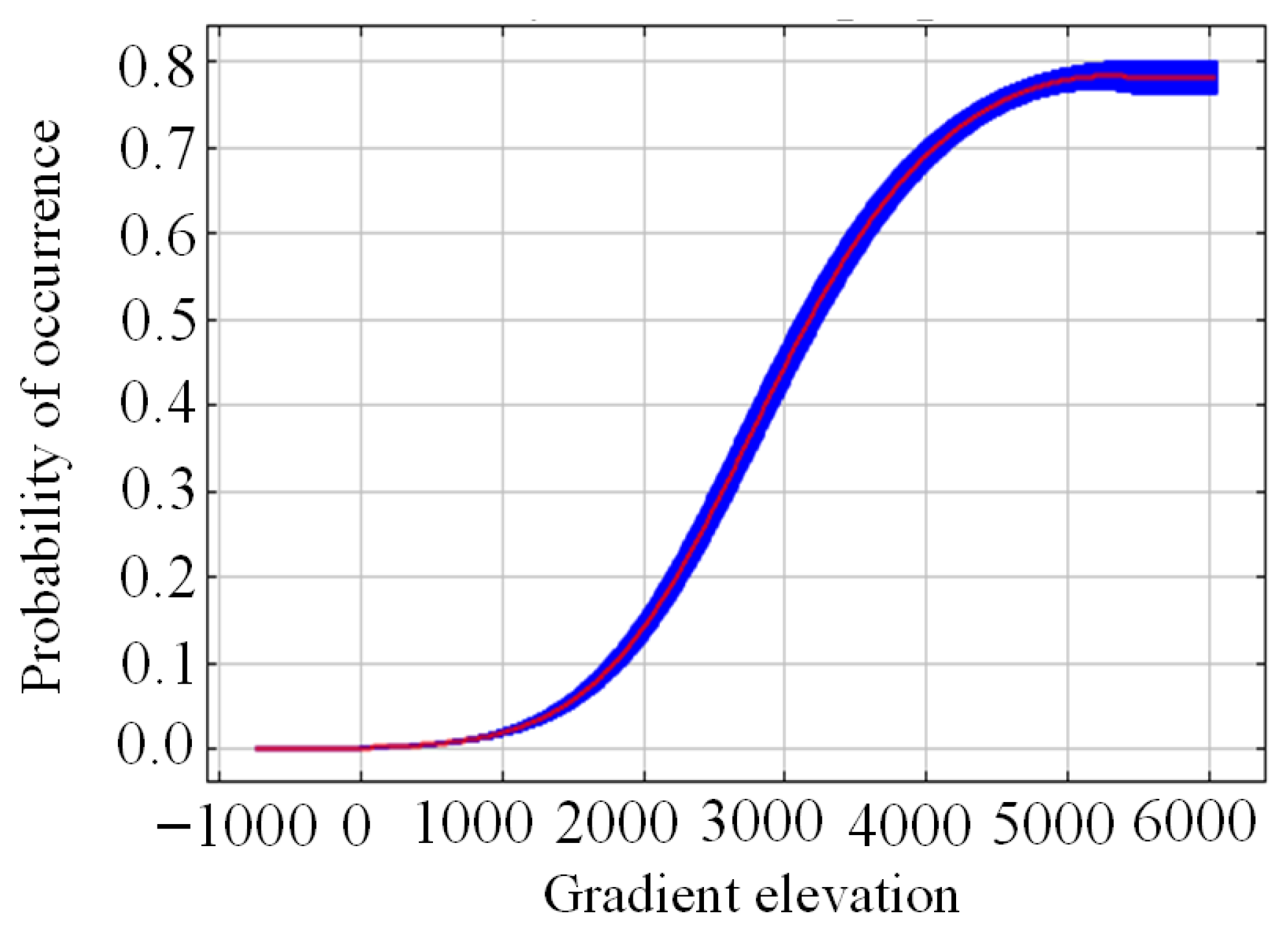
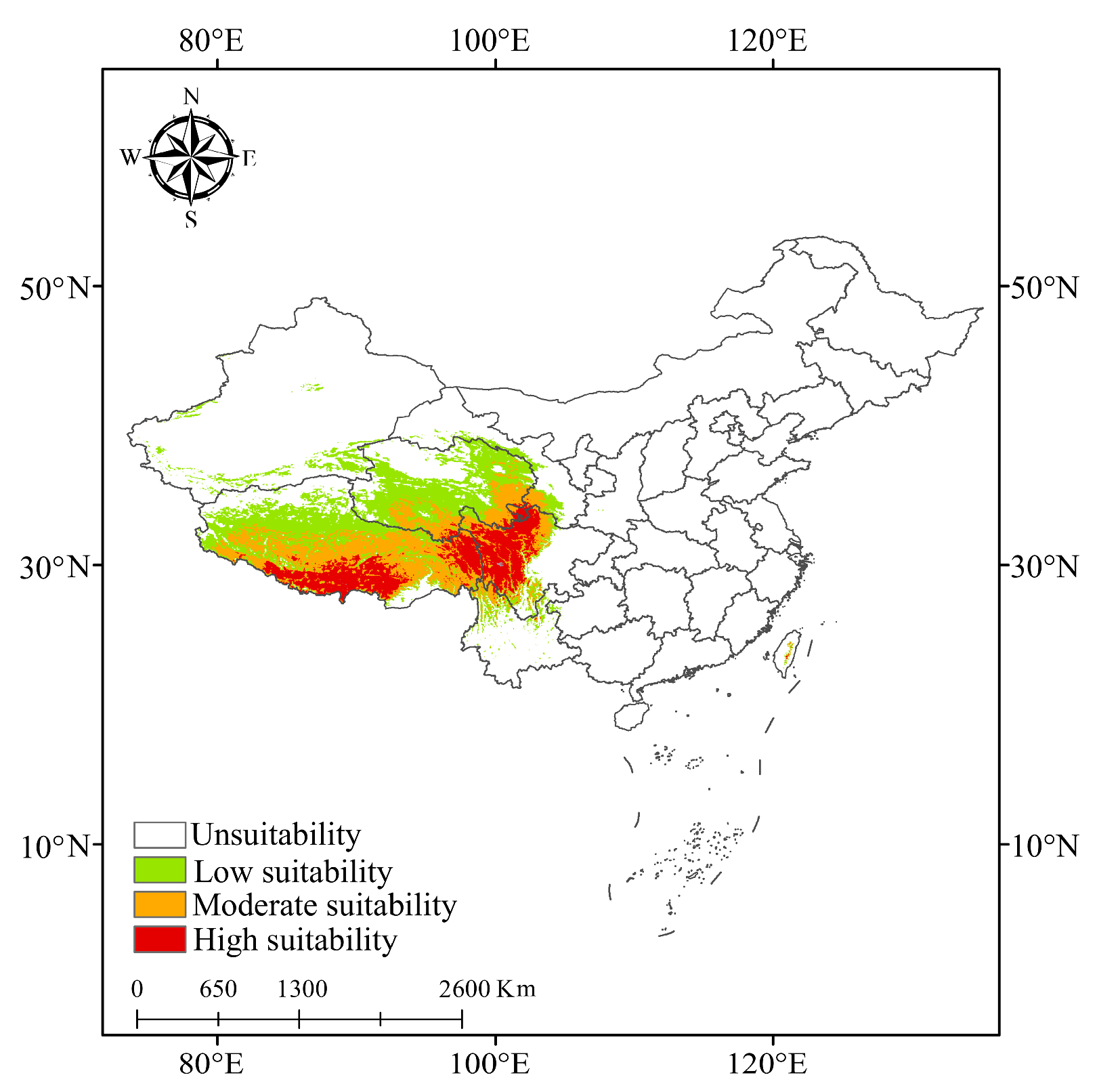
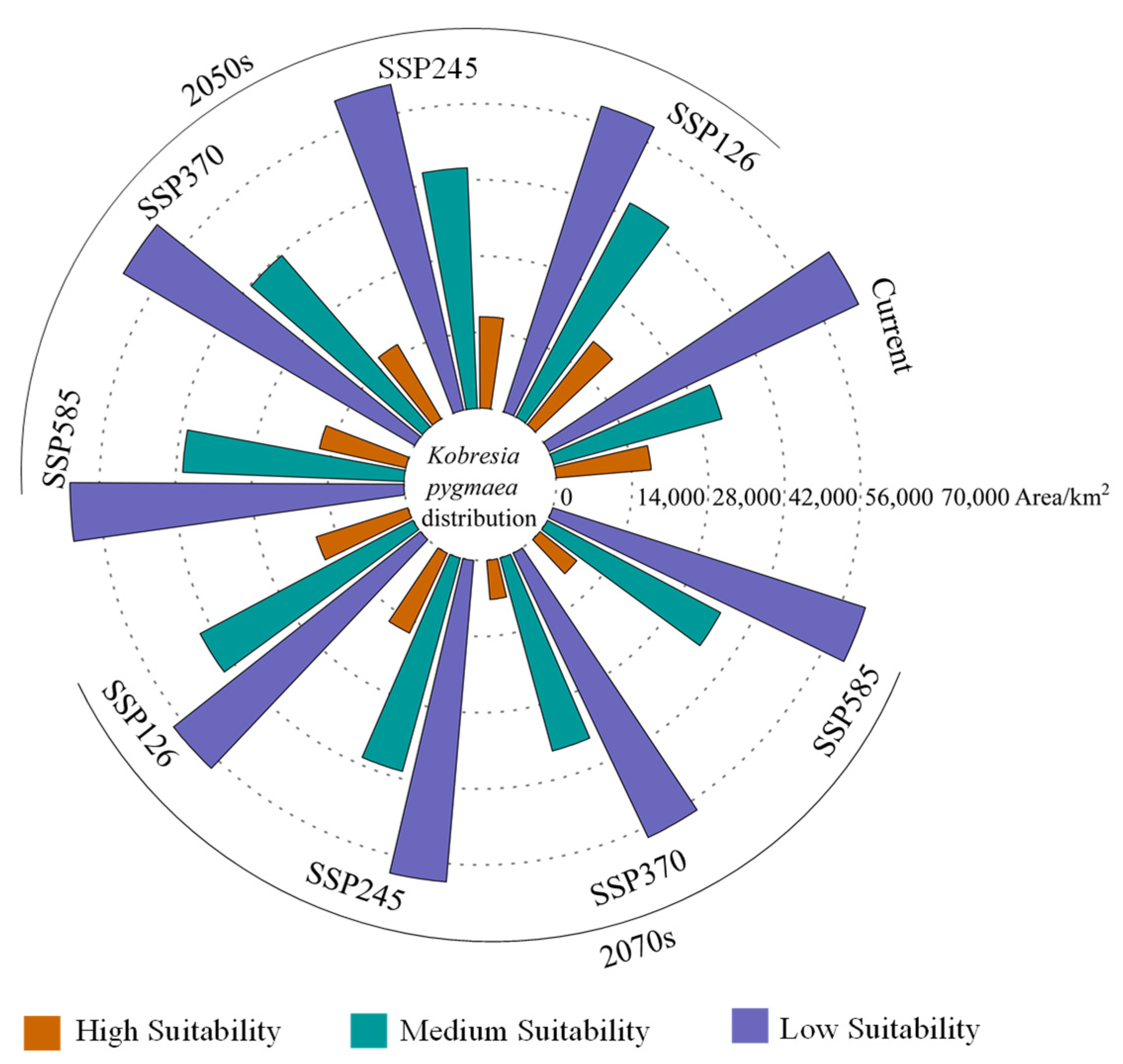
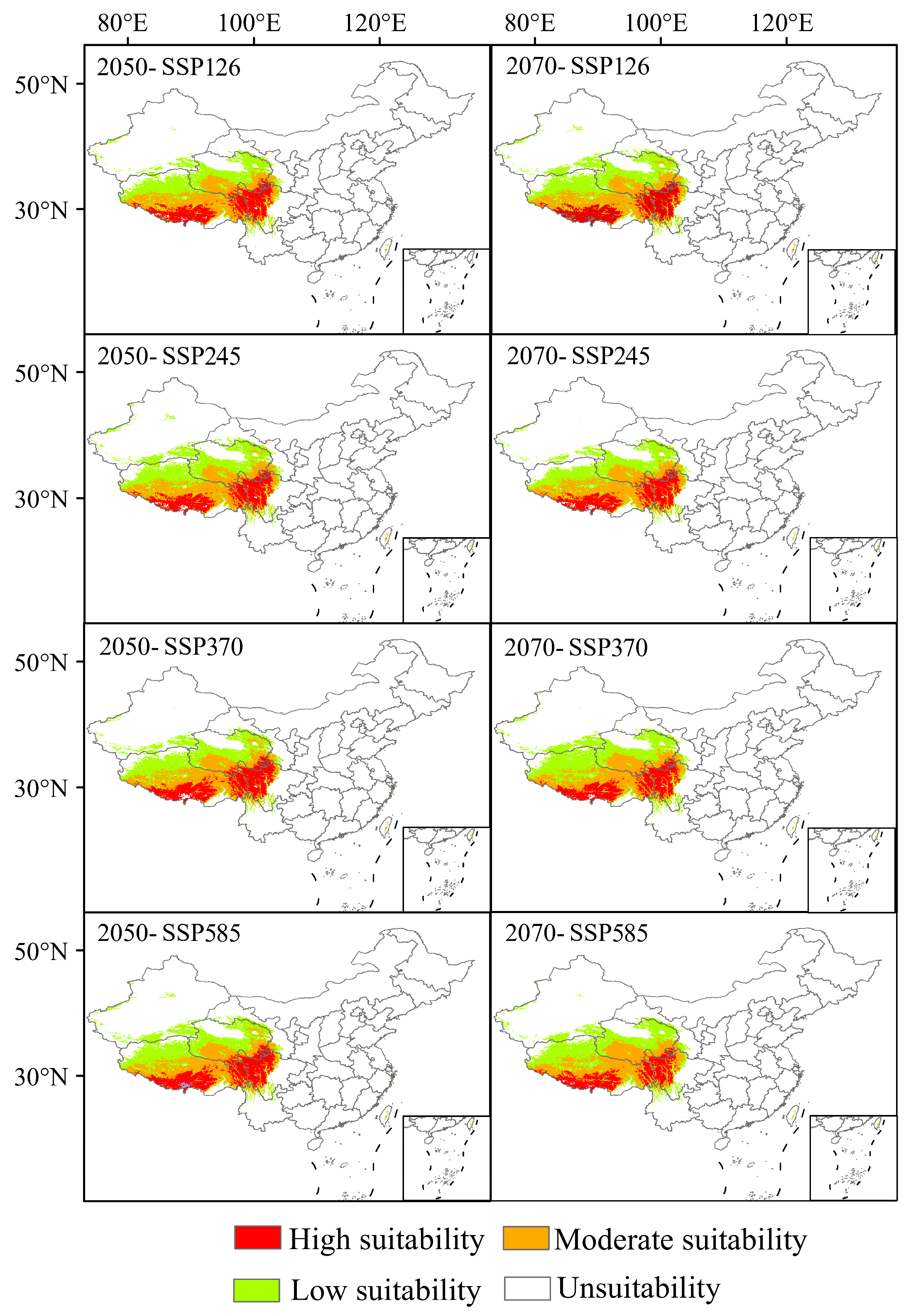
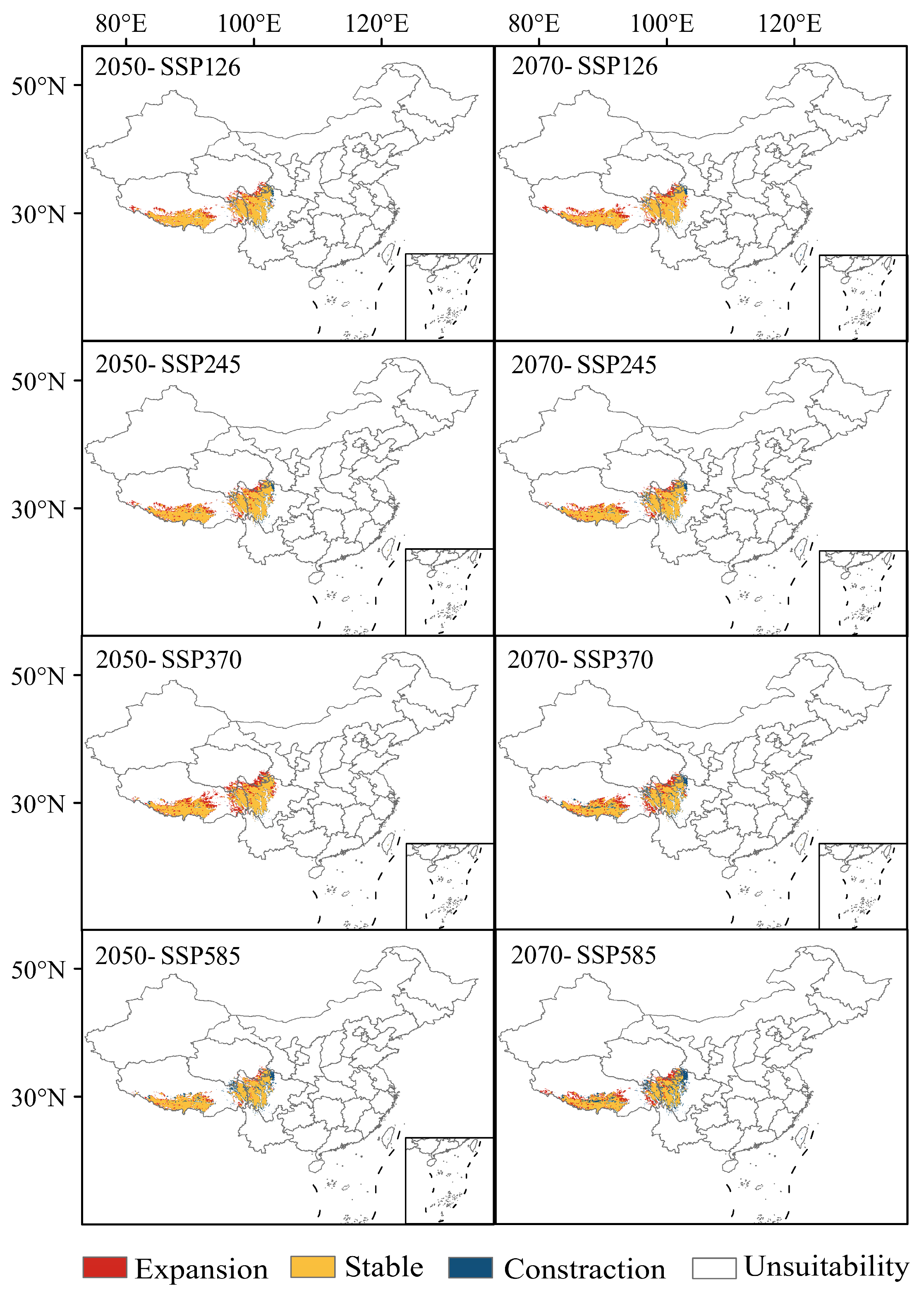

| Variable | Name | Percent Contribution (%) |
|---|---|---|
| wc2.1_2.5m_elev | Altitude | 66.4 |
| bio9 | Mean temperature of driest quarter (°C) | 10.3 |
| bio1 | Annual mean temperature | 3.1 |
| bio18 | Precipitation of the warmest quarter (mm) | 2.2 |
| bio14 | Precipitation of driest month (mm) | 1.4 |
| bio4 | Temperature seasonality | 1.4 |
| bio6 | Minimum temperature of coldest month (°C) | 0.9 |
| t_bs | Topsoil base saturation | 0.5 |
Disclaimer/Publisher’s Note: The statements, opinions and data contained in all publications are solely those of the individual author(s) and contributor(s) and not of MDPI and/or the editor(s). MDPI and/or the editor(s) disclaim responsibility for any injury to people or property resulting from any ideas, methods, instructions or products referred to in the content. |
© 2025 by the authors. Licensee MDPI, Basel, Switzerland. This article is an open access article distributed under the terms and conditions of the Creative Commons Attribution (CC BY) license (https://creativecommons.org/licenses/by/4.0/).
Share and Cite
Cai, Z.; Li, F.; Bao, S.; Zhang, H.; Shi, J. Climate Change and Habitat Fragmentation: Implications for the Future Distribution and Assisted Migration of Kobresia pygmaea. Plants 2025, 14, 3585. https://doi.org/10.3390/plants14233585
Cai Z, Li F, Bao S, Zhang H, Shi J. Climate Change and Habitat Fragmentation: Implications for the Future Distribution and Assisted Migration of Kobresia pygmaea. Plants. 2025; 14(23):3585. https://doi.org/10.3390/plants14233585
Chicago/Turabian StyleCai, Zongcheng, Fayi Li, Shancun Bao, Hairong Zhang, and Jianjun Shi. 2025. "Climate Change and Habitat Fragmentation: Implications for the Future Distribution and Assisted Migration of Kobresia pygmaea" Plants 14, no. 23: 3585. https://doi.org/10.3390/plants14233585
APA StyleCai, Z., Li, F., Bao, S., Zhang, H., & Shi, J. (2025). Climate Change and Habitat Fragmentation: Implications for the Future Distribution and Assisted Migration of Kobresia pygmaea. Plants, 14(23), 3585. https://doi.org/10.3390/plants14233585





